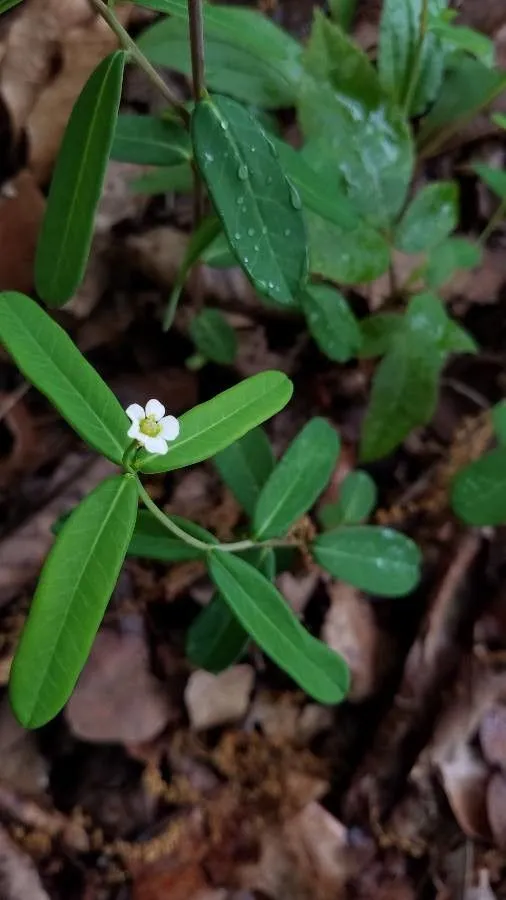
Author: L.
Bibliography: Sp. Pl.: 459 (1753)
Year: 1753
Status: accepted
Rank: species
Genus: Euphorbia
Vegetable: False
Observations: SE. Canada to C. & E. U.S.A.
Poison-milkweed, scientifically known as Euphorbia corollata, is a fascinating and notable species within the family Euphorbiaceae. First described by the renowned botanist Carl Linnaeus in his seminal work “Species Plantarum” in 1753, this plant has since intrigued both botanists and plant enthusiasts alike.
Native to a broad geographical range, Poison-milkweed thrives in regions extending from southeastern Canada through to central and eastern parts of the United States. This adaptability to various environments showcases the plant’s robustness and resilience.
Morphologically, Poison-milkweed is characterized by its striking appearance. It often exhibits an array of delicate, white blossoms clustered together to form a captivating display. Each flower, though small, contributes to an overall semblance of elegance and simplicity, making the plant easily recognizable and distinguishable.
Despite its charming appearance, it is paramount to acknowledge the plant’s toxic nature, which is alluded to in its common name. The milky sap exuded by the plant contains chemicals that can be harmful if ingested or if they come into contact with skin. This dual nature of allure and danger has made Poison-milkweed a subject of caution and respect among those who encounter it.
In ecological terms, Euphorbia corollata plays a significant role. It has adapted well to its native habitats, contributing to the biodiversity of the regions it inhabits. The plant often serves as a part of the local flora’s intricate web, supporting various forms of wildlife while also asserting its unique presence.
In horticulture, while some may seek to cultivate this plant for its ornamental qualities, it is imperative to approach with care, given its toxic properties. Proper handling and situating it appropriately within garden settings where human and pet interactions can be minimized are essential measures for those looking to introduce Poison-milkweed into cultivated spaces.
In summary, Euphorbia corollata or Poison-milkweed is not just a plant of striking beauty but also one of intriguing complexity. Its dual nature of allure and toxicity commands a blend of admiration and caution, securing its place as a noteworthy subject within the vast tapestry of the plant kingdom.
Eng: american spurge, flowering spurge, floweringspurge euphorbia, poison-milkweed, blooming spurge, eastern flowering spurge
Deu: amerikanische wolfsmilch
Fra: euphorbe pétaloïde
En: Poison-milkweed, Flowering spurge, American spurge, FLOWERINGSPURGE EUPHORBIA, Blooming spurge, Eastern flowering spurge
Fr: Euphorbe pétaloïde
De: Amerikanische Wolfsmilch
Taken Apr 14, 2021 by Rick D (cc-by-sa)
Taken Jan 1, 1900 by EOL − Cooper, G.A. (cc-by-nc-sa)
Taken Sep 29, 2021 by dixie cousins (cc-by-sa)
Taken Aug 9, 2020 by Robert Breeding (cc-by-sa)
Taken Sep 9, 2019 by Bruce Winter (cc-by-sa)
Taken Sep 29, 2021 by dixie cousins (cc-by-sa)
Taken Aug 16, 2020 by Logan McNiece (cc-by-sa)
Taken Oct 2, 2016 by huy HO (cc-by-sa)
Taken Aug 29, 2020 by richard burger (cc-by-sa)
Taken Mar 8, 2014 by EOL − Aarongunnar (cc-by-sa)
Taken Jan 12, 2022 by Taylor Shook (cc-by-sa)
Taken Jan 12, 2022 by Taylor Shook (cc-by-sa)
Taken Sep 9, 2019 by Bruce Winter (cc-by-sa)
Taken Aug 16, 2020 by Logan McNiece (cc-by-sa)
Taken Jul 22, 2022 by William Coville (cc-by-sa)
Taken Aug 18, 2020 by MakerMagpie (cc-by-sa)
Taken Oct 2, 2016 by huy HO (cc-by-sa)
Growth habit: Forb/herb
Family: Myrtaceae Author: (F.Muell.) K.D.Hill & L.A.S.Johnson Bibliography: Telopea 6: 402 (1995) Year: 1995 Status:…
Family: Rubiaceae Author: Pierre ex A.Froehner Bibliography: Notizbl. Bot. Gart. Berlin-Dahlem 1: 237 (1897) Year:…
Family: Sapindaceae Author: Koidz. Bibliography: J. Coll. Sci. Imp. Univ. Tokyo 32(1): 38 (1911) Year:…
Family: Asteraceae Author: A.Gray Bibliography: Pacif. Railr. Rep.: 107 (1857) Year: 1857 Status: accepted Rank:…
Family: Fabaceae Author: Medik. Bibliography: Vorles. Churpfälz. Phys.-Ökon. Ges. 2: 398 (1787) Year: 1787 Status:…
Family: Aspleniaceae Author: (Cav.) Alston Bibliography: Bull. Misc. Inform. Kew 1932: 309 (1932) Year: 1932…